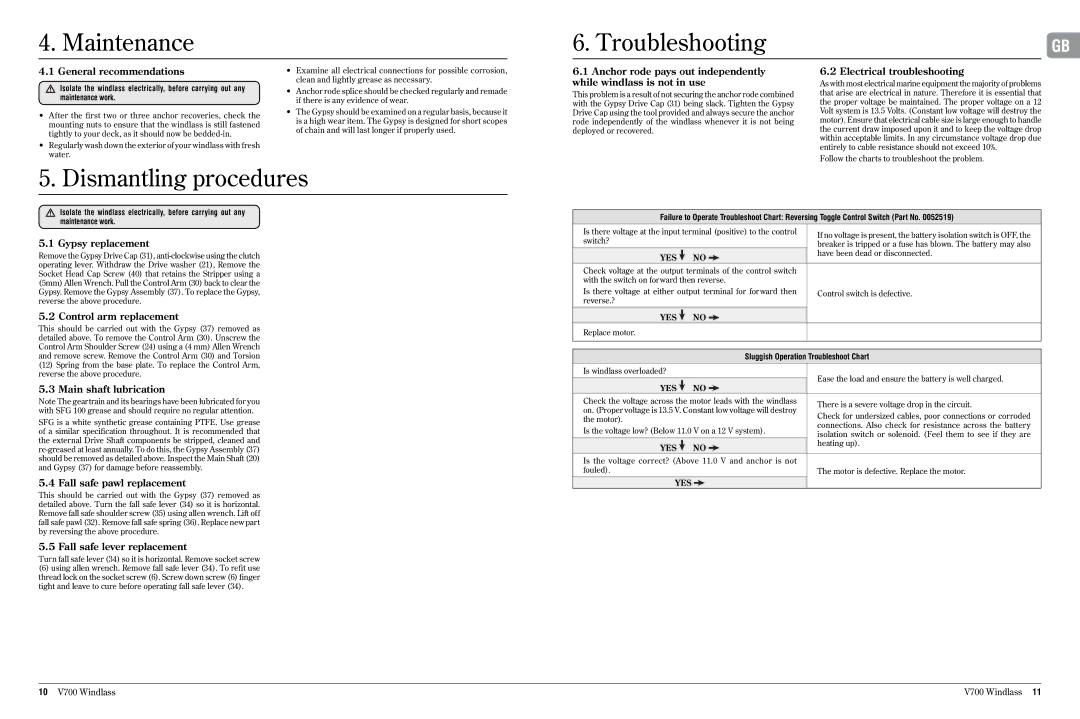
4. Maintenance
6. Troubleshooting | GB |
4.1 General recommendations | • Examine all electrical connections for possible corrosion, |
| clean and lightly grease as necessary. |
6.1 Anchor rode pays out independently |
while windlass is not in use |
6.2 Electrical troubleshooting
As with most electrical marine equipment the majority of problems
Isolate the windlass electrically, before carrying out any maintenance work.
•After the first two or three anchor recoveries, check the mounting nuts to ensure that the windlass is still fastened tightly to your deck, as it should now be
•Regularly wash down the exterior of your windlass with fresh water.
•Anchor rode splice should be checked regularly and remade if there is any evidence of wear.
•The Gypsy should be examined on a regular basis, because it is a high wear item. The Gypsy is designed for short scopes of chain and will last longer if properly used.
This problem is a result of not securing the anchor rode combined with the Gypsy Drive Cap (31) being slack. Tighten the Gypsy Drive Cap using the tool provided and always secure the anchor rode independently of the windlass whenever it is not being deployed or recovered.
that arise are electrical in nature. Therefore it is essential that the proper voltage be maintained. The proper voltage on a 12 Volt system is 13.5 Volts. (Constant low voltage will destroy the motor). Ensure that electrical cable size is large enough to handle the current draw imposed upon it and to keep the voltage drop within acceptable limits. In any circumstance voltage drop due entirely to cable resistance should not exceed 10%.
Follow the charts to troubleshoot the problem.
5. Dismantling procedures
Isolate the windlass electrically, before carrying out any maintenance work.
5.1 Gypsy replacement
Remove the Gypsy Drive Cap (31),
5.2 Control arm replacement
This should be carried out with the Gypsy (37) removed as detailed above. To remove the Control Arm (30). Unscrew the Control Arm Shoulder Screw (24) using a (4 mm) Allen Wrench and remove screw. Remove the Control Arm (30) and Torsion
(12)Spring from the base plate. To replace the Control Arm, reverse the above procedure.
5.3 Main shaft lubrication
Note The geartrain and its bearings have been lubricated for you with SFG 100 grease and should require no regular attention.
SFG is a white synthetic grease containing PTFE. Use grease of a similar specification throughout. It is recommended that the external Drive Shaft components be stripped, cleaned and
5.4 Fall safe pawl replacement
This should be carried out with the Gypsy (37) removed as detailed above. Turn the fall safe lever (34) so it is horizontal. Remove fall safe shoulder screw (35) using allen wrench. Lift off fall safe pawl (32). Remove fall safe spring (36). Replace new part by reversing the above procedure.
5.5 Fall safe lever replacement
Turn fall safe lever (34) so it is horizontal. Remove socket screw
(6)using allen wrench. Remove fall safe lever (34). To refit use thread lock on the socket screw (6). Screw down screw (6) finger tight and leave to cure before operating fall safe lever (34).
Failure to Operate Troubleshoot Chart: Reversing Toggle Control Switch (Part No. 0052519)
Is there voltage at the input terminal (positive) to the control | If no voltage is present, the battery isolation switch is OFF, the | ||||||||
switch? |
|
|
|
|
| ||||
|
|
|
|
| breaker is tripped or a fuse has blown. The battery may also | ||||
|
|
|
|
|
|
|
| ||
|
|
| NO |
|
| have been dead or disconnected. | |||
|
|
|
|
| |||||
YES |
|
| |||||||
|
|
| |||||||
Check voltage at the output terminals of the control switch |
| ||||||||
with the switch on forward then reverse. |
| ||||||||
Is there voltage at either output terminal for forward then | Control switch is defective. | ||||||||
reverse.? |
|
|
|
|
|
| |||
|
|
|
|
| |||||
YES |
|
| NO |
|
|
| |||
|
| ||||||||
|
|
|
| ||||||
Replace motor. |
|
|
|
|
|
| |||
|
|
|
|
|
|
|
|
| |
|
|
|
|
|
|
|
| ||
|
|
|
|
|
|
| Sluggish Operation Troubleshoot Chart | ||
Is windlass overloaded? |
|
|
|
|
| Ease the load and ensure the battery is well charged. | |||
|
|
|
|
|
|
|
| ||
YES |
|
| NO |
|
| ||||
|
|
|
| ||||||
|
|
|
|
| |||||
|
|
|
| ||||||
Check the voltage across the motor leads with the windlass | There is a severe voltage drop in the circuit. | ||||||||
on. (Proper voltage is 13.5 V. Constant low voltage will destroy | |||||||||
Check for undersized cables, poor connections or corroded | |||||||||
the motor). |
|
|
|
|
| ||||
|
|
|
|
| connections. Also check for resistance across the battery | ||||
Is the voltage low? (Below 11.0 V on a 12 V system). | |||||||||
isolation switch or solenoid. (Feel them to see if they are | |||||||||
|
|
|
|
|
|
|
| ||
|
|
|
|
|
|
|
| heating up). | |
|
|
|
|
|
|
|
| ||
YES | NO |
|
| ||||||
|
|
| |||||||
Is the voltage correct? (Above 11.0 V and anchor is not |
| ||||||||
fouled). |
|
|
|
|
| The motor is defective. Replace the motor. | |||
YES |
|
|
|
|
|
| |||
|
|
|
|
|
| ||||
10 V700 Windlass | V700 Windlass 11 |
